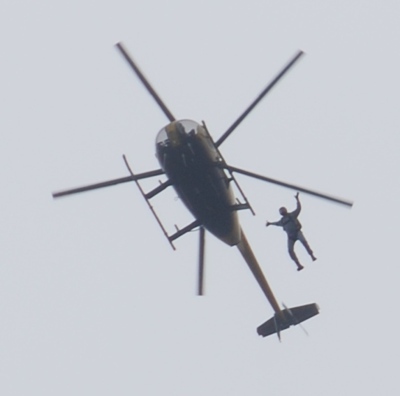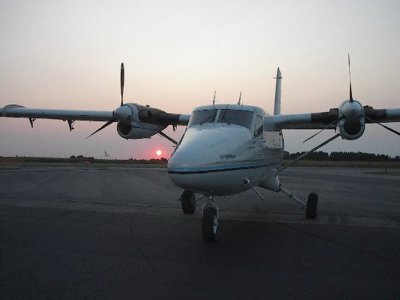Are you willing to land with the jump plane in the name of pilot training?
By
skybum02, in Safety and Training
Recommended Posts
tombuch 0
Quote"As Mark said, it's illegal in some jump planes"
What is the reference for that statement?
Sec. 91.107
Use of safety belts, shoulder harnesses, and child restraint systems.
(a) Unless otherwise authorized by the Administrator--
(1) No pilot may take off a U.S.-registered civil aircraft (except a free balloon that incorporates a basket or gondola, or an airship type certificated before November 2, 1987) unless the pilot in command of that aircraft ensures that each person on board is briefed on how to fasten and
unfasten that person's safety belt and, if installed, shoulder harness.
(2) No pilot may cause to be moved on the surface, take off, or land a U.S.-registered civil aircraft (except a free balloon that incorporates a basket or gondola, or an airship type certificated before November 2, 1987) unless the pilot in command of that aircraft ensures that each person on board has been notified to fasten his or her safety belt and, if installed, his or her shoulder harness.
(3) Except as provided in this paragraph, each person on board a U.S.-registered civil aircraft (except a free balloon that incorporates a basket or gondola or an airship type certificated before November 2, 1987) must occupy an approved seat or berth with a safety belt and, if installed, shoulder harness, properly secured about him or her during movement on the surface, takeoff, and landing. For seaplane and float equipped rotorcraft operations during movement on the surface, the person pushing off the seaplane or rotorcraft from the dock and the person mooring the seaplane or rotorcraft at the dock are excepted from the preceding seating and safety belt requirements. Notwithstanding the preceding requirements of this paragraph, a person may:
(i) Be held by an adult who is occupying an approved seat or berth, provided that the person being held has not reached his or her second birthday and does not occupy or use any restraining device;
(ii) Use the floor of the aircraft as a seat, provided that the person is on board for the purpose of engaging in sport parachuting;
Instructor Emeritus
Comm Pilot MSEL,G
Author: JUMP! Skydiving Made Fun and Easy
I tend to believe the 'operational safety performance' parameters can allow for a pilot to 'handle' both situations (full/empty) without too many issues.
I have heard a full load will be better in a gusty situations. So, to test the final product the DZO and his family should gear up maybe....not the customers.
I have landed in a our 206 ~10 times(DNJ). about another 5 for trips for regular maintenance. One more - full weight for a bunch of us to check out a 182. From all that, Pavement made more of a 'impression' on me than weight of the plane.
Would a tail dragger (185, PC-6, etc) be more problematic in a no power full load emerg landing?
The scariest thing I've seen was an inspection port hanging off the strbrd horizontal stabilizer. I informed the pilot. He asked what it was, I said wait, and grabbed it and it took 1.5 turns on the screw to have it drop off into my hands. We taxi'd back when I placed the port into the pilot's hands. Nice walk around buddy. My lesson from that is all pilots are not equal. So get good pilots and keep them. Training is profitable in the long run isn't it?
Bill
MakeItHappen 15
QuoteSince when is landing in a plane so dangerous? As scary as landings are in jump planes, I'd rather land in one than take off in one! Unfortunately it doesn't work that way...
Dave
I think there is a difference between landing a full load with everything working right and landing a full load that is simulating or has a real emergency. The OP said these practice landings would be simulating emergencies. That means the pilot would probably pull power from an engine. That is additional risk. If the DZ or pilot paid the jumpers and had a 'test dummy' contract with them, that would be different. A free jump is not payment enough, especially when you subject yourself to additional risk. There are plenty of ways to get free jumps without additional risk.
I've been on a lot of loads that have had an engine failure. The best jump plane for this to happen in is a DC3. Hell, Howie gave us two passes on one engine. The Visions guys always asked for a cut when the right engine was out. Of course, they didn't get it.
On one loss of engine on takeoff at Coolidge, the DC3 turned and landed on the cross-bar of the 'A'.
On another Beech load at Coolidge, we lost the right engine around 10K. The pilot said we could do our normal exit. I was a floater. It was really strange looking over the plane and seeing the prop stationary. (In hindsight, I think this was probably not the best thing to do.)
The best thing any jumper can do for an engine out below 1000k is sit tight, in the crash position and STFU.
Your life is in the hands of the pilot now. There are pilots that can fly an Otter, DC3 or Beech on one engine.
I've even seen an Otter pilot takeoff with only one engine, empty load.
There are pilots that can fly a Cessna with no engine. Make sure you fly with one of those pilots.
They get their proficiency by training and tending to the number one job of flying the plane.
It would be irresponsible and negligent if a Cessna pilot says 'Say folks, before going to altitude, I'm going to try my hand at a dead stick landing.' or if a twin engine pilot says 'Say folks, before going to altitude, I'm going to pull power on one engine, right after takeoff and try to make the runway.'
.
Make It Happen
Parachute History
DiveMaker
billvon 3,173
kkeenan 14
QuoteHey, if people feel like they'd rather have balast on board during normal full plane landing practice then do it. But it needs to be done.
Yes, it definitely needs to be done. But not with people as the "ballast". This can be a high-risk operation, with the jumpers too low to be anything other than victims if things go bad. The only thing you save by using people is that it's easier than loading some secured weight. That's no reason to risk your friends. The sad part is that plenty of people see no problem going along with this. It's just an unnecessary risk.
Kevin K.
Dude, you are so awesome...
Can I be on your ash jump ?
QuoteI've landed 150's with just myself and 182's with four people in them. And while they present different challenges, neither one seemed unusually dangerous to me
However, the handling characteristics are very different in a 182 with just the pilot on board, and one loaded to gross weight with the CG near the aft limit.
As part of my factory checkout in the Columbia 350, they had us practice some landings with the CG at the forward limit, and others with shot bags in the back to get the CG aft so we could feel the difference.
Most check outs I've been given in 182's have been with just 2 on board with a forward CG. When I give a check out, I insist on a few times around the pattern and stalls with a few cases of oil, etc., as ballast so the pilot can feel the difference.
In a 206, you just about need full nose up trim to land it when alone, but a healthy dose of nose down trim at gross with an aft cg.
Neither is dangerous, unless the pilot is in a high stress situation that has not been previously experienced in a low stress situation, i.e., training.
Blue Skies!
Harry
"Your statement answered your question."
QuoteThe sad part is that plenty of people see no problem going along with this. It's just an unnecessary risk.
It's sad that skydivers are willing to land in a plane?
I can understand Jan's point above that if we're talking about pulling engines after takeoff and having the pilot try to make it back to the runway in one piece, fine...that's an unnecessary risk. But all that the original poster was talking about was having the pilot make a heavy landing once a month for practice.
I'd have no problem going for a quick sight seeing flight around the pattern. If I trust the pilot to get me off the ground safely, I definitely trust him to get me back on the ground too.
Too bad jump planes can't have a feature found in many large helicopters... One Engine Inop and heavy-weight training modes. Flip a switch and the helicopter acts like you've just had an engine failure (on a multi-engine helicopter) including fake indications on the panel (except it says "TRAINING"). Or another switch to simulate heavy gross weight. No need for ballast. Unfortunately that wouldn't work on a plane.
Dave
DBCOOPER 5
QuoteQuote"As Mark said, it's illegal in some jump planes"
What is the reference for that statement?
Sec. 91.107
(ii) Use the floor of the aircraft as a seat, provided that the person is on board for the purpose of engaging in sport parachuting;
I don't see where that says you can't land a plane full of skydivers. If a student balks, do you have to throw them out?
If you do not trust your pilot enough to land with him, you have no business getting in the aircraft.Helping them maintain proficiency should be something you would want to do.
If the plane is unrecoverable then exiting is a very very good idea.
billvon 3,173
>If a student balks, do you have to throw them out?
No - because he got on the plane for the purpose of skydiving. If you get on the plane for the purpose of skydiving, and have to land due to (say) ATC conflicts, that's OK. If you get on board for the PURPOSE of flight training (not jumping) then you can't be sitting on the floor.
This comes up on occasion when aircraft are used to ferry skydivers to a boogie or something. Per the FAA, all passengers must sit in approved seats during such a flight, unless they intend to get out before landing and are doing so within 25 miles of takeoff. (This rule is often bent.)
edited to fix distance
Icon134 0
even though I don't enjoy it much (in fact its a bit scary)... especially with a partially/full load of jumpers.
DBCOOPER 5
Quote>I don't see where that says you can't land a plane full of skydivers.
>If a student balks, do you have to throw them out?
No - because he got on the plane for the purpose of skydiving. If you get on the plane for the purpose of skydiving, and have to land due to (say) ATC conflicts, that's OK. If you get on board for the PURPOSE of flight training (not jumping) then you can't be sitting on the floor.
This comes up on occasion when aircraft are used to ferry skydivers to a boogie or something. Per the FAA, all passengers must sit in approved seats during such a flight, unless they intend to get out before landing and are doing so within 25 miles of takeoff. (This rule is often bent.)
edited to fix distance
That is only if they are paying(mileage limit).If they "share expenses" and plan to jump in, that does not apply. Then there is the drop zone waiver issue when they get there.
If the plane is unrecoverable then exiting is a very very good idea.
tombuch 0
QuoteQuote>I don't see where that says you can't land a plane full of skydivers.
>If a student balks, do you have to throw them out?
No - because he got on the plane for the purpose of skydiving. If you get on the plane for the purpose of skydiving, and have to land due to (say) ATC conflicts, that's OK. If you get on board for the PURPOSE of flight training (not jumping) then you can't be sitting on the floor.
This comes up on occasion when aircraft are used to ferry skydivers to a boogie or something. Per the FAA, all passengers must sit in approved seats during such a flight, unless they intend to get out before landing and are doing so within 25 miles of takeoff. (This rule is often bent.)
edited to fix distance
That is only if they are paying(mileage limit).If they "share expenses" and plan to jump in, that does not apply. Then there is the drop zone waiver issue when they get there.
I think you are mixing your regulations. I don't want to get too deep into the books or type each regulation, but the quick paraphrase is:
91.107 says every passenger must occupy a seat, but skydivers may use the floor as a seat if they intend to jump. There is no distance limitation or exemption under this regulation. It applies to every flight.
119.1 specifies higher regulations for commercial operations, but then exempts skydiving flights within 25 miles of the airport of take off, and allows them to be conducted under the more lenient part 91.
So using a skydiving aircraft to transport jumpers more than 25 miles runs afoul of 119.1. Using the floor as a seat for a sightseeing flight runs afoul of 91.107. Using the floor as a seat for a flight with a landing point in excess of 25 miles runs afoul of both.
Instructor Emeritus
Comm Pilot MSEL,G
Author: JUMP! Skydiving Made Fun and Easy
AirCav 0
The other FARs to consider are the ones prohibitting passengers while conducting training unless they are crew members also being trained. (I may be getting the Parts mixed up though, 61,91,135,121) I'd have to research that.
At any rate, ( in my opinion as a check airman), any training with passengers on board is not a good idea.
If people want to do this training I feel it should be with ballast and not people.
( ref Murhy's Law)
WGore 0
Don't get me wrong I'm not disputing the intent of the law just the common sense of it. If the jumpers are geared up and they make a circuit and then take off again and climb to altitude, you could make a case for the law being complied with.
At the DZ that I fly at, we could find enough staff to do such training and usually do. But we are operating single engine aircraft, so not a big deal. The other thing we do is start new jump pilots out with lighter loads till they get comfortable with the aircraft. All of our pilots are very experienced jumpers or they don't fly for us, (no time builders).
Typically they will have 10 to 12 hours with an experienced jump pilot before they see a skydiver and they will get a dead stick landing during that training.
What I didn't articulate was that when suggesting people land with a full load I was refering to NORMAL landing practice. Some very sharp people have pointed out the FARs that suggest this is not legal and they are totally right! My apologies. I should have known that.
As for doing any type of emergency training (engine out SE/ME) you should NOT have pax on board. That is absolutely true. And when landing training for engine out in a ME plane you SHOULD NOT feather a good engine but rather simulate zero thrust. Feathering an engine for landing practice IS CREATING A REAL EMERGENCY! Securing an engine in flight for the purpose of demonstration is common, accepted practice. Make sure you understand what the manufacturer says about that type of practice too.
And when conducting emergency training you MUST, MUST MUST! brief exactly what is going to happen and what you expect the training pilot to do. There should be no doubt as to what is expected. It's training, not testing.
www.diverdriver.com
ATP/D-19012
FB #4125
Another point is that landing a full jump plane is not necessarily an emergency procedure and thus practicing one is not necessarily emergency training. I have landed in a full jump plane for various reasons from low clouds to an ATC shortage. Both of these situations could have afforded everyone on board a safe jump, but not at the altitude they purchased; there was no emergency.




.thumb.jpg.4bb795e2eaf21b8b300039a5e1ec7f92.jpg)



What is the reference for that statement?
If the plane is unrecoverable then exiting is a very very good idea.
Share this post
Link to post
Share on other sites